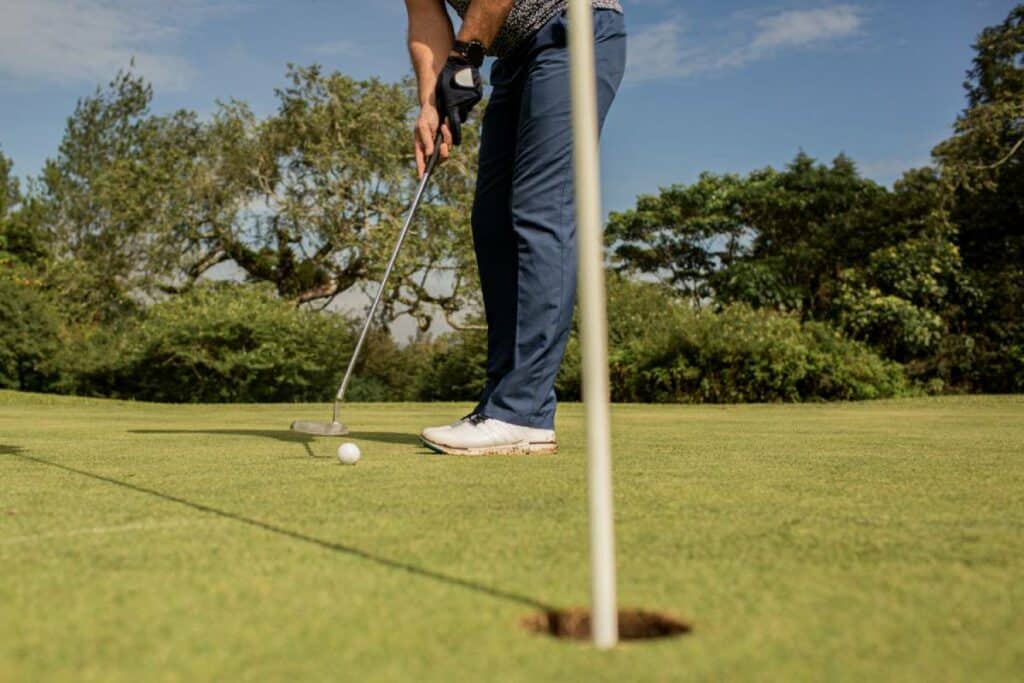Last Updated on October 23, 2023
Golf is a game enjoyed by millions of people worldwide, with players ranging from casual weekend golfers to professional competitors. Have you ever wondered where some of golf’s most popular terms come from? From birdies and bogeys to sand traps and mulligans, it turns out that each term has its own fascinating story behind it. In this article, we’ll explore the origins of these common golf terms.
Origin of Equipment Names
Golf clubs, golf balls, golf bags, golf carts and golf tees are all essential components of golf. Each piece of equipment has a unique name that originates from centuries-old traditions and stories. The origins of these names can provide insight into the evolution of this beloved sport.
The term’ golf club’ dates back to at least 1550 in Scotland when the first known reference to the game was made. Historically, players would use primitive wooden sticks to hit their ball further down a course. Over time, metal heads were added to increase accuracy and distance. These early clubs served as an inspiration for modern-day drivers and irons we see today.
Golf balls have long been associated with royalty due to their expensive materials, such as ivory or leather, used in production during earlier times, while more affordable synthetic options became available later on in history. This likely explains why they were referred to simply as “the king’s plaything”. Golf bags evolved out of necessity; traditional sets had only 4-5 clubs, so carrying them around was relatively easy without any special cases needed until larger collections emerged over time. Similarly, the need for wheeled transportation called forth the advent of golf carts which could transport both player and gear conveniently across courses much faster than walking alone ever could. Finally, teeing up before taking a shot is an integral part of every round, but this practice didn’t become popularised until William Bloxsom patented his ‘teeing peg’ invention in 1889, making it easier for players to place their ball atop a small mound prior to swinging away at it.
Derivation of Golf Course Terminology
Golf course terminology has a distinct set of words and phrases associated. The term derivation origin of these terms is varied, as some have evolved over time while others are derived from people or places in the sport’s history.
Some golf course terminology comes from Scotland, where the game originated. For example, the word ‘tee’ was likely derived from an old Scots term for small hills that were used to launch balls into play during early games. Similarly, popular terms such as ‘fore’ (an exclamation shouted when someone hits their ball too close to another) and ‘links’ (a type of terrain found on many courses), both come from Scottish roots.
Other golf course terminology comes from American culture. The phrase ‘mulligan’, which refers to taking a second shot after hitting a bad one, was coined by American golfer David Balfour Mulligan in 1930s Canada. Meanwhile, the concept behind ‘water hazard’ came about due to changes in land use necessitated by industrialisation; water hazards became common obstacles on golf courses throughout America and Europe at this time.
Etymology of Golf Lingo
Golf has its own unique language, and understanding the etymology of golf lingo is integral to playing the game. Golf terms have evolved over time as players adopted their own terminology for the sport. From “teeing off” to “birdie,” the origin of many popular phrases can be traced back centuries.
The term “bogey” was originally used in England during the late 19th century and referred to a score that was one stroke higher than par on a hole. Similarly, a “birdie” is thought to have derived from an American phrase “, a bird of a shot,” which referred to scoring one under par on a single hole. Other terms such as “driving range” or “doglegs” are much more modern inventions but still play an important role in golf language today.
It’s clear that much of our current golf slang comes from previous generations who found creative ways to describe common elements of playing golf. Even if you’re not familiar with all these words, having general knowledge about where they come from will help bring some context while enjoying your next round.
Impact of Slang on Golf Terminology

Golf slang, golf terminology and golf lingo often incorporate expressions from everyday language. This has allowed certain words or phrases to become commonplace in the sport of golf. Slang influence is seen when terms such as “ace” used for a hole-in-one or “birdie” used for one stroke under par are adopted into general golf usage. Golfers use these expressions to describe their shots, whether they are good or bad. As well, some popular sayings have been adapted from the common culture that may provide humour during play on the course.
Using slang in golf does not replace proper etiquette and rules of play set out by governing bodies. It is important that players know both the right terms and understand how to act respectably while playing the game. All in all, slang should be used sparingly to ensure clarity between different players and to maintain an atmosphere conducive to having fun while also following the regulations of competitive play. Ultimately, understanding basic rules, as well as being aware of any changes made with respect to a new language, will help give everyone an enjoyable round of golfing.
Frequently Asked Questions
What Is the Most Popular Golf Term in Use Today?
The most popular golf term in use today is the “longest drive,” which refers to the longest shot hit by a golfer during a round of play. This phrase has become commonplace among golfers, from weekend warriors hitting balls at their local driving range to professional players competing on the PGA Tour. The concept behind this phrase can be traced back to some of golf’s earliest traditions, when early enthusiasts would compete for bragging rights with respect to who had hit the furthest tee shot down the fairway.
Golf clubs have evolved over time and are now designed specifically for different shots; however, all clubs tend to share similar characteristics that make them easily identifiable across various brands and models. A typical set of golf clubs includes a driver – the club used to take the longest drives – as well as wedges, irons, hybrids, and putters. Each of these types of clubs plays an important role in helping golfers execute complex strategies, such as shaping shots around obstacles or landing approach shots close enough to sink putts. In addition, many experienced players keep several extra clubs in their golf bags so they can customise their selection based on course conditions or individual preferences.
Therefore, it makes perfect sense why “the longest drive” remains one of the most commonly used phrases in modern-day golf lingo: it speaks directly to a fundamental element within every player’s game—striking the ball long off the tee box. Whether you’re playing your favourite home course or looking for ways to improve your score against competitors on tour, understanding how far each type of club flies can help you decide which one will yield the best results during any given situation.
Conclusion
In conclusion, golf is a game that has been around for centuries, and its terminology reflects this. The most popular term in use today is ‘par’, which originated from the French phrase meaning ‘equal’. But it can also be very challenging at times – making courses like St Andrews the toughest to beat. Golf offers something for everyone, no matter what your skill level or experience may be; whether you are looking to relax with friends or take on a challenge against yourself or others, there will always be an opportunity to learn and enjoy the game.


